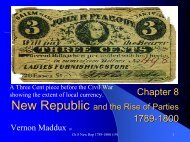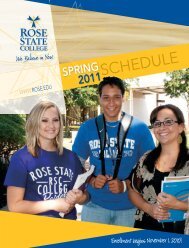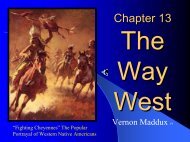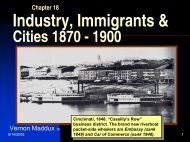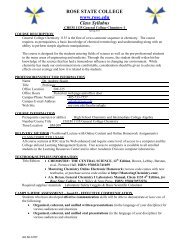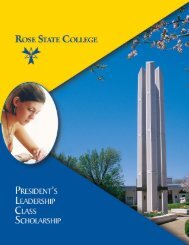Chapter 4: Convergence and Conflict 1660-1789
Chapter 4: Convergence and Conflict 1660-1789
Chapter 4: Convergence and Conflict 1660-1789
You also want an ePaper? Increase the reach of your titles
YUMPU automatically turns print PDFs into web optimized ePapers that Google loves.
Imperial Economics: MercantilismParliament dem<strong>and</strong>s an absolute Monopoly of colonial raw materials• <strong>1660</strong>. Parliament creates aNavigation Act to enhancemaximum economic developmentfor Engl<strong>and</strong> by requiring allcolonial goods to be sent directlyto London or Bristol to be taxed.• The Navigation Act is renewed<strong>and</strong> refined during the next 100years. It prohibits Dutch <strong>and</strong>French merchants from tradingdirectly with American colonists.• 1700 a new “Yankee Enterprise”Colonial Rhode Isl<strong>and</strong> scene, 1690.spirit develops in New Engl<strong>and</strong>which includes smuggling.3Ch 4 <strong>Convergence</strong>, <strong>Conflict</strong> <strong>1660</strong>-1763 (14)
Regulation of TradeNavigation Act41715, Boston. Rules <strong>and</strong>Requirements of Navigation Act• “(Parliament) forbids all Personswhomsoever of holding any Correspondence,Commerce, Trade <strong>and</strong> Dealings … with the Frenchof Canada, Cape Breton or other Parts…”• All goods <strong>and</strong> raw materials from everyEnglish colony around the world wererequired by British law to betransported in British ships withBritish crews-directly to Engl<strong>and</strong> to beinventoried <strong>and</strong> taxed. Only then couldcolonial items be sold in foreigncountries.• English merchants were thus givenabsolute control over colonial goods.• Since they fixed the price for thegoods, they were assured a profit.• British middle <strong>and</strong> upper classes,become extremely wealthy,Ch 4 <strong>Convergence</strong>, <strong>Conflict</strong> <strong>1660</strong>-1763 (14)
Colonial Politics – Dominion of New Engl<strong>and</strong>Massachusetts, Rhode Isl<strong>and</strong>, Connecticut, New HampshireDOMINION OF NEWENGLAND 1687-89 NewEngl<strong>and</strong>-New York- New JerseyNew YorkNew Jersey• 1689, Winter. News of theGlorious Revolutionarrives to great rejoicing inthe New World.• New Engl<strong>and</strong>ers mistakenly assumethey are free to reject their hatedroyal governor.• Gov. Sir Edmund Andros flees hisBoston mansion dressed inwomen’s clothing.• His boots show beneath his dress<strong>and</strong> he is captured.• Thrown in jail, he is deported toEngl<strong>and</strong> in the Spring of 1689• William & Mary, however,are displeased by theactions of the NewEngl<strong>and</strong> colonists.6Ch 4 <strong>Convergence</strong>, <strong>Conflict</strong> <strong>1660</strong>-1763 (14)
Colonial Politics – The South 1689-1733Delaware, Maryl<strong>and</strong>, Virginia, Carolina <strong>and</strong> Georgia7Delaware(1635)Chesapeake BayPiedmont TidewaterCharlestonCape Hatteras• After 1700 all colonies borderingChesapeake Bay grow slave-plantedtobacco.• Each colony is governed byassemblies that routinely bribes theroyal governor in order to maintainself-rule.• 1700. All Southern colonies aredominated by wealthy oligarchies(marriage-connected families).• 1730. Carolina, formerly a satelliteof Virginia, is split in two colonies-North <strong>and</strong> South.• 1733. King George II permits JamesEdward Oglethorpe to foundGeorgia as a buffer against theSpanish.Ch 4 <strong>Convergence</strong>, <strong>Conflict</strong> <strong>1660</strong>-1763 (14)
First Great Awakening 1734 The first trulyAmerican religious institution, “New Light, Born-Again Christian” is created.8Cotton Mather 1662-1728An “Old Light” Puritan• 1692 Puritan Cotton Mather arguedagainst the witch trials butdefended the death sentences.• 1728 Mather <strong>and</strong> Arminian “OldLight” Calvinist religious leaderslost followers when JonathanEdwards led a series of “NewLight” revivals-now known as the“First Great Awakening.”• The fervent outpouring of religious“Born Again” excitement surprised<strong>and</strong> shocked European <strong>and</strong>American intellectuals (includingBen Franklin).• These revivals boosted the individual“Spirit of Enterprise” <strong>and</strong> selfconfidencethat was spreading throughNew Engl<strong>and</strong>.Ch 4 <strong>Convergence</strong>, <strong>Conflict</strong> <strong>1660</strong>-1763 (14)
Jonathan Edwards9The “New Lights” believedFirst True American Churchesthe old established Puritanchurch could not be reformed.• 1734. Northampton, Mass.Edwards preached IICorinthians 6:17 "Come outfrom among them <strong>and</strong> be yeseparate."• 1735. Separatist Baptists fromBoston claimed “Born Again”was more important for apreacher than a Harvardeducation- they spread rapidlysouth into Virginia <strong>and</strong> NorthCarolina.• 1736. John Wesley readEdward’s sermons in London<strong>and</strong> created the “Methodist”Jonathan Edwards1703-1758Church which jumped toGeorgia.Ch 4 <strong>Convergence</strong>, <strong>Conflict</strong> <strong>1660</strong>-1763 (14)
10Meanwhile Out West Spanish NuevoMexico, Tejas <strong>and</strong> Alta CaliforniaUte warrior rides a horsetaken from the Spanish in1680.1540. Coronado explored through NewMexico, Texas <strong>and</strong> Kansas but returnedto Mexico disgusted by the lack of gold.It took 168 more years for the Spanishto establish a North American colony.1608. Santa Fe, Nuevo Mexico, is foundedby Juan Onate’.• Spanish ruled with an iron fist.• The Pueblos <strong>and</strong> Utes become slaves.1680. Pueblos united behind Pope’ <strong>and</strong>drove out the Spanish, killing 400.1700. Pueblo society descends into chaos<strong>and</strong> the Spanish are asked to return.1710. The Utes; Navajos; Comanches, <strong>and</strong>Kiowas obtain horses <strong>and</strong> soon raidNew Mexican settlements at will.Ch 4 <strong>Convergence</strong>, <strong>Conflict</strong> <strong>1660</strong>-1763 (14)
11New Engl<strong>and</strong> isseparated from Canadaby only the 4-5,000’Appalachian MountainpeaksMeanwhile Up NorthFrench Canada• 1600. France begins tradewith the Hurons.• 1608-42. Quebec, 8 othersettlements are foundedalong the St Lawrence R.• 1689. The English “GloriousRevolution” caused CatholicFrance <strong>and</strong> its Indian alliesto declare war on ProtestantNew Engl<strong>and</strong>.• 1690-1763. French &Indians use hit <strong>and</strong> runattacks at sea <strong>and</strong> againstoutlying New Engl<strong>and</strong>settlements.Ch 4 <strong>Convergence</strong>, <strong>Conflict</strong> <strong>1660</strong>-1763 (14)
North America73 Years of sporadic warfare asFrench Canadian Indians attackedNew Engl<strong>and</strong> frontier towns.12In 1751, Parliamentreorganized <strong>and</strong> modernizedthe British army which servedrarely in North America.The four “official” colonial wars ofFrance <strong>and</strong> Engl<strong>and</strong> fought in NorthAmerica are known as follows:• King William’s war 1689-97.• Treaty of Ryswick, Belgium.• Queen Anne’s war 1702-14.• Great British gains Newfoundl<strong>and</strong>,Nova Scotia <strong>and</strong> Hudson Bay bythe Treaty of Utrecht.• King George’s war 1740-48.• Treaty of Aix-le-Chapell no gain.• French & Indian war 1752-63.Ch 4 <strong>Convergence</strong>, <strong>Conflict</strong> <strong>1660</strong>-1763 (14)
French vs. British 1689-1763.“Cold War” often hot in North AmericaBy 1738 in Europe <strong>and</strong> inthe West, a continuing “cold war”between Great Britain <strong>and</strong> France ismarked by increasing hostility.The usual atrocities-murder, rape,kidnapping-are rampant along theAppalachian frontier betweenCanada <strong>and</strong> the British colonies.• Especially in upstate New York <strong>and</strong>down the Ohio Valley, both sidesFrench allied Huron warriorsravaged upstate New York<strong>and</strong> down into the OhioValleyrecruit Native American warriors<strong>and</strong> use them as surrogate militiasoldiers.13Ch 4 <strong>Convergence</strong>, <strong>Conflict</strong> <strong>1660</strong>-1763 (14)
French & Indian War 1752-1763Gen. Braddock <strong>and</strong> The Battle of Three ForksPennsylvania, July 9, 175514Major General Edward Braddock isshot from his horse while GeorgeWashington rallies the 44 th <strong>and</strong> 48 thRegiments.• George Washington, DanielBoone, John Finley, DanielMorgan, Charles Lee, HoratioGates, Thomas Gage; dozens offuture American Revolutionaryofficers marched with the BritishArmy to confront the French.• This battle marks the first majorfighting of the French & IndianWar which spreads to Europe <strong>and</strong>becomes the final war for worlddomination between the twosuperpowers.• Braddock is mortally wounded,dies <strong>and</strong> is buried in the road fourdays later.• Washington is credited withsaving British soldiers from beingmassacred.Ch 4 <strong>Convergence</strong>, <strong>Conflict</strong> <strong>1660</strong>-1763 (14)




